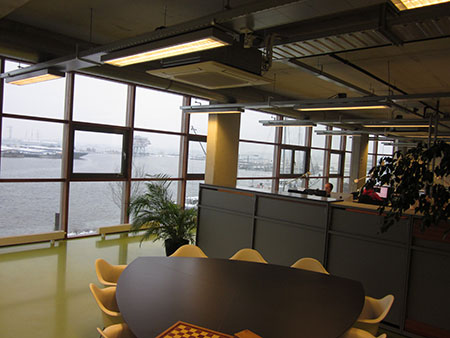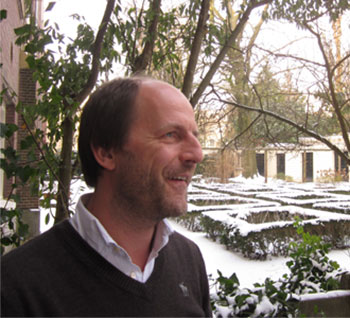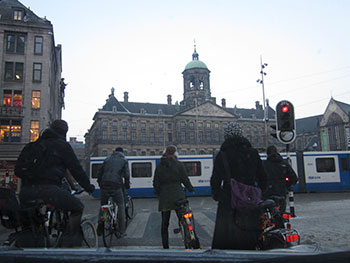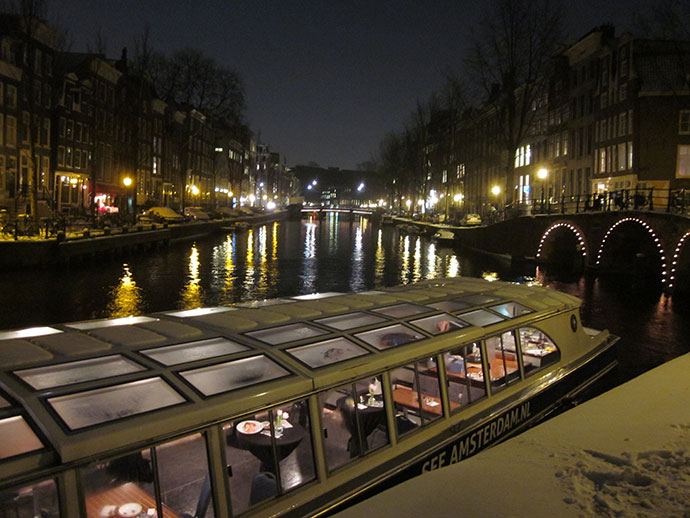“The purpose of the state is freedom.”
— Dutch philosopher and Amsterdammer Baruch Spinoza
What if, instead of designing business incubators, accelerators and other science-inflected names for workspace, your whole city was that workshop, custom-designed for exploration, discovery and serendipitous interaction?
Such places mostly exist in artist’s renderings. But a select few have been around in the real world for some time. In Amsterdam’s case, it amounts to about 400 years.
From the moment you enter the city, you can see why there’s no need to build a special workspace. It’s already surrounding you, waiting for you to walk and bike its byways, to bounce from experience to experience, and to wonder at its curiosities, among them the massed bicycles, the constant citrus, the tall, lean people framed in tall, lean windows, and, always, the golden light.
“There are a lot of great cities where you don’t feel like you’re at home,” says Mike Lee, a former Apple employee who was a founder and “mayor” of Appsterdam, a community of app creators housed right in the city’s center. “I was here 24 hours and I felt like I lived here.” He says the city is the entrée to Europe for a lot of people, partly because of its accessibility via the English language.
“A big chunk of experienced technologists in this field are Americans,” says Lee. “One advantage Amsterdam has over Berlin is you can emigrate in English. If you are an entrepreneur and want to start a company, you are basically given residency status for free. We can call the Dutch immigration service and ask for pre-flighting — it’s not something available over email in most countries, enabled by the Dutch-American Friendship Treaty, which was originally put in place for manufacturers, then hung around for years as a vestige. When I came in, I had to present as a manufacturer of business goods.”
Appsterdam CEO Paul Darcey, originally from Australia, says Appsterdam could have happened anywhere, and there’s “nothing wrong” with Berlin, Dublin and Copenhagen when it comes to the buzz of the creative hive. “But this place here has all the good stuff,” he says, “and all the good stuff for work.”
He’s not alone in thinking that: According to numbers released in early February by amsterdam inbusiness (aib), the international marketing and acquisitions organization of the Amsterdam Metropolitan Area, 126 new international companies chose to set up shop in the metro area in 2012, accounting for the direct creation of 1,344 new jobs. Eleven existing international companies in the region opted to expand their activities last year, creating another 600 new jobs. Most of the growing firms are active in the ICT, creative and business services sectors.
Today some 2,000 international companies have operations in Amsterdam, accounting for 15 percent of overall employment. Last year 25 international companies established their headquarters in the region, accounting for 972 new jobs. In 2011, 37 percent of the companies establishing themselves in the region were from the U.S. In 2012, that proportion rose to 46.5 percent.
Attracting freedom lovers is in the DNA of the city, whether that freedom is related to the markets, religion, social customs or artistic expression.
Kees Zandvliet, the curator for a Golden Age exhibit at the Amsterdam Museum, says the city was the Manhattan of the early 17th century. People were migrating to cities, and the nuclear family was becoming the norm. Instruments such as the market exchange and the company concept helped to propel the city. Calvinists ran things, he says, but freedom of conscience was a principle of the Republic, made official in 1579, that extended a welcome to such persecuted groups as Jews and French Huguenots. At the time, there were problems in France, England and Germany. “Holland was a safe bubble in the middle,” he says. “A lot of people with talent came here.”

Unique creative industries workspaces like this one are popping up in the Timber Docklands district at the Port of Amsterdam.
Damrak, formed by damming the Amstel River, was the most important inland harbor in the world during Amsterdam’s Golden Age. Today, while the Port of Amsterdam continues to complement the larger sister port of Rotterdam, its Timber Docklands area is seeing pronounced redevelopment to welcome creative industries, with locations from such firms as Saatchi & Saatchi, Tuvulu, Tom’s shoes, Tommy Hilfiger and Sony Pictures, which is investing in two studios in the harbor district.
“The area is still new and ‘rough,’ ” says Pieter Bas Hendriks with developer Heren 2 B.V. “The creative possibilities are more open than in the city.” The rents are lower too: just below €200 per sq. m., compared to an average of between €300 and €350 in the city’s central business district. Bas Hendriks sees the “anti-development” ethos of the area as, ironically, a potential boon to the area.
“I think there will be a transformation from big buildings with big company-name signs on the side to refocusing on the work force,” he says, “creating positive work space for the people, so they like to be here.”
Unique Vibe
Mike Lee founded Appsterdam two years ago during a year-long post-Apple world tour with friend and Appsterdam COO Judy Chen. Among the things that impressed him was the city’s cost of living, especially compared with the premium paid by those trying to make a go of it in San Francisco or Seattle. He also liked the place’s coziness. And Appsterdam’s slogan “Everyone is welcome” couldn’t find a better match in a city whose current nationality count hovers around 180.
“Berlin, like every city in the world, is built to be this great monument to the hubris of cities,” he says. “The Dutch try to make their cities livable. Everyone can come together on a middle ground … We’re bringing technical people here together in a non-technical way who are making apps and changing the world.”

Onno Bakker, co-founder of eBuddy, likes the ambiance of his company’s courtyard in any season.
Onno Bakker is chief technology officer and co-founder of Web and mobile messaging firm eBuddy, which employs nearly 100 people of 27 nationalities and processes some 17 billion messages a month for more than 33 million unique monthly users. The company maintains its headquarters in Amsterdam in part of a former ABN Amro building, next door to the city archives, and also has offices in Singapore and San Francisco. A decade ago the company had the chance to make the leap to Sand Hill Road in Silicon Valley at the behest of venture capitalists. It didn’t go.
“By that time we were 10 people, and it was hard to move the whole company,” says Bakker. “We could compare salaries and quality of personnel, and we figured there is quite a good pool of talent here, or people willing to move here. And we had our first international employees from Vietnam and China. So we thought, ‘If the cost is considerably lower, why move the company?’ “
Colleague André Sommer, a Brazilian, says it’s a very competitive landscape as the firm competes with the Googles and Facebooks of the world for talent. But then he looks at his 10-minute walk to work, compared to sitting in the Tube for an hour in London or sitting in traffic for three hours in his native country.
“I find it rather remarkable how we attract people, not only young professionals, but people with their families,” he says, noting 19 current job vacancies. That’s aided by a transparent immigration system in the Netherlands. “There is a set of rules, but you can work with them,” he says.
Helping make eBuddy’s business case are recently introduced subsidies for innovation and technology work branded as the Innovation Box, and the fact that expatriates receive a 30-percent break on the country’s income taxes during their first five years in the country.
Creative Taxation?
A similar multicultural dynamic is at work just around the corner at international advertising and marketing agency 180, which calls itself “proudly diverse: 95 people, 15 languages, 19 nationalities, 1 cat.” The company has performed work for such customers as DHL, Formula One and Western Union.
“I’ve worked in London and New York, but when you come here, the blinkers come off,” says Stephen Corlett, managing director. “Suddenly you see a whole world. In London and New York there are a lot of people just like you. Here there are a lot of people unlike you.”
When the firm started in 1998, he says, its location choice was heavily influenced by the fact that “Holland was giving so many great tax breaks to come here.” Amsterdam was a longtime cultural hub, but as a creative hotbed for the advertising sector, he says, it’s only happened in the past 15 years, with the locations of firms such as Weiden Kennedy and Adidas. “We have a sister agency in Los Angeles in a beach house,” he says. “The L.A. people all want to come here.”
Helping eBuddy, 180 and a host of firms (including a strong financial services cluster) is the city’s status as an Internet node. In the Internet economy, says eBuddy’s Onno Bakker, three months is like a year.
“The Internet space was fast, but mobile Internet is even faster,” he says. Amsterdam’s attractiveness to talent is buttressed by its speed and low latency as a European telecommunications hub. The relative speed was enough to convince the firm to shut down its development office in Minsk, Russia.
“We found it difficult to have development in two locations,” says Jan-Joost “JJ” Rueb, CEO and co-founder of eBuddy. “We gained a bit in speed, but it was not [by a factor of] three, it was 1.5. In this competitive environment, you want the whole team to be together. You can’t lose time thinking by two teams not in the same location. There’s basically no time.
“We convinced some of the people to move from Minsk to Amsterdam,” he says. “It was not a hard sell.”
When those newcomers arrive, they might just find themselves meeting others like them … sort of like those serendipitous encounters every incubator in the world is trying to spark.

Bike usage in Amsterdam has grown by more than 40 percent in the last 20 years, from 340,000 daily journeys to 490,000 in 2008. The number of bicycle journeys to and from train stations is expected to rise by 25 percent by 2020.
“One thing that does distinguish Amsterdam is it’s a physically small city,” says Paul Darcey at Appsterdam, citing his own experiences trying to get around in larger cities such as London, Berlin and Sydney. “Here it’s anywhere in the city in half an hour by bike. It’s a lot easier to randomly bump into people.”
Even governments don’t mind being bumped into. New initiatives from governments ranging from the city to the country to the EU itself are looking to groups like Appsterdam to help them be as innovative as the companies they seek to attract. Appsterdam co-founder Mike Lee says the local tax office sought out his group’s input in order to make working there “cool.” And the EU’s work on open data is moving from idea contests and hackathons to sponsoring mentorships that result in people getting paid to work on successful apps.
“You’ve not heard about the infamously wonderful government services apps of Europe yet,” jokes Lee, but you might soon. “Crappy apps for the government make the world a worse place. A program that’s increasing transparency needs to be successful.”
All indications are that the transparent openness of Amsterdam translates into successful start-ups, companies whose maturation doesn’t necessarily mean they want to go elsewhere.
“My original intention was to figure out where I wanted to live and what I wanted to work on,” says Appsterdam’s Mike Lee. “The conclusion I came to was that Amsterdam was the best place in the world to live, a bit like Epcot Center meets Burning Man, a great place for adult activities like writing code and raising children.
“Amsterdam,” says Lee, “is an ideal that has existed for centuries.”
City inhabitants: 800,000
Bicycles: 881,000
Percentage of people who cycle daily: 58 percent
Metro Area Inhabitants: 2,289,762
Nationalities: 180
Parks: 40
Trams: 255
Ferries: 9
Canals: 165
Bridges: 1,281
Houseboats: 2,500
16th, 17th and 18th century buildings: 8,863
Museums: 51
Paintings by Rembrandt: 22
Paintings by Van Gogh: 206
Historical church organs: 42
Theatres and concert halls: 55
Concerts and theatrical performances per year: 16,000
Cafés and bars: 1,515
Restaurants: 1,150
Hotels: 370
